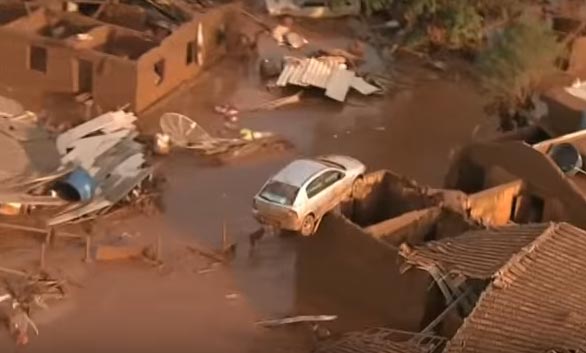VANCOUVER — Mining giants BHP Billiton (NYSE: BHP; LSE: BLT) and Vale (NYSE: VALE) haven’t offered much detail about a large-scale tailings dam breach at the Samarco iron ore joint venture in Brazil’s Minas Gerais state, but reports already show it could be one of the largest-ever mining-related disasters in terms of area of impact.
It was near dusk on Nov. 5 when residents in the nearby town of Bento Rodrigues reportedly heard a thundering boom, followed by a flood of mud and tailings waste that levelled the community.
Pictures released from the area reveal widespread devastation, and preliminary reports from Minas Gerais state authorities indicate that four people were killed and another 30 were injured. The population in the affected area is estimated to exceed 600.
Meanwhile, BHP reported “at least one confirmed fatality,” with another 13 members of the workforce missing.
Samarco’s dams are composed of four structures: Germano, Fundao, Santarem and Cava de Germano. The Brazilian company’s CEO, Ricardo Vescovi, released a video on social media soon after the disaster to report that the Fundao and Santarem dams had ruptured at the Germano complex. Samarco said that all people rescued were taken to emergency care in Mariana — a tourist centre 300 km north of Rio de Janeiro — and other nearby municipalities.
“We still don’t know the full extent of the situation. It happened shortly before dusk, and we’re working close with Vale so that we can understand the circumstance better, as quickly as possible,” BHP CEO Andrew Mackenzie said at a press conference in Melbourne, Australia.
“We have, of course, offered our full and complete assistance to the Samarco team and the local authorities. The first thing is to manage the immediate rescue efforts, and then the clean up and subsequent investigation. The mine is a fifty-fifty joint venture within a Brazilian company,” he added.
Samarco said its operating licences were issued by the regional environmental office, which does recurring inspections of the integrity of the dam structures. The last inspection reportedly took place in July 2015. Samarco said it conducts its own inspections under the Federal Law of Dam Safety, and has operations teams rotating in 24-hour shifts. The operational mining licences were subsequently suspended.
The Samarco mine has an annual production capacity of more than 21 million tonnes of iron ore pellets, and 1 million tonnes of concentrates. The complex includes open-pit mines, a concentration plant, two pellet plants, port facilities and a 400 km concentrate slurry pipeline.
BHP reported that Samarco’s third-quarter production jumped 9% year-on-year to 7.5 million tonnes of iron ore after the fourth pellet plant ramped up. The companies said the waste from the dam breach “consists mostly of silica [sand] from iron ore processing, and presents no chemical that is harmful to health.”
Scotiabank Metals & Mining Analyst Mark Turner says Samarco was on track to produce 29.3 million tonnes of iron ore pellet product this year, and 30.4 million tonnes in 2016. This represents 24% of Vale’s attributable pellet production in 2015.
Vale president and CEO Murilo Ferreira said that “we would like to express our solidarity to all affected by this accident at Samarco’s tailings dams in the state of Minas Gerais. We will do everything in our power to offer all the necessary support to Samarco and the authorities at this sad time for employees, their family members and the neighbouring communities.”


How could something that “killed 4 people and injured another 30” from preliminary reports could be seen as “one of the largest mining-related disasters in history”? I feel awful for those affected by this incident, but let’s get serious.
Guess even the Northern Miner is caught up in the ridiculous anti-mining sentiment. Farming, logging, and mining are the basic industries of the world. And the statement, “If it can’t be mined, it has to be grown” comes to mind.
I have had more friends killed in a single car accident, than this mining accident.